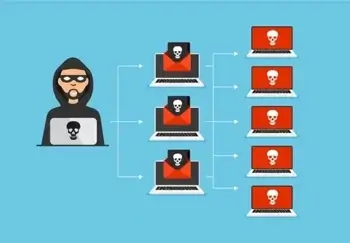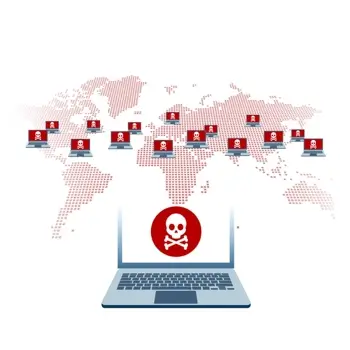What Is a Botnet? What You Need to Know to Protect Yourself
In today’s digital age, botnets are one of the most dangerous and elusive weapons cybercriminals use. Hackers manipulate botnets to commit cybercrimes, including Distributed Denial of Service (DDoS) attacks, stealing personal information, sending spam, and spreading malware. In this article, learn what a botnet is and how they work. Furthermore, learn how to protect yourself from becoming a zombie in a hacker’s bot army.
What is a botnet?

A botnet by definition is a network of malware-infected machines controlled by a hacker or group of hackers from a command center. It takes advantage of devices from computers and smartphones to routers and Internet of Things (IoT) devices; essentially, any device connected to the Internet could become part of a bot network if infected with the right malware. These devices then carry out malicious acts and cybercrimes.
Botnets are a serious threat for users and a great tool for hackers because there is power in numbers when it comes to computing. With hundreds of thousands or even millions of bots at their disposal, the hacker, "bot herder," or “bot master” can carry out any number of large-scale attacks. The larger the network, the more powerful it is and the more damage it can cause.
How do botnets work?
Bot masters infect devices with Trojan malware viruses, usually through phishing emails or malicious downloads, and gain control of them remotely. Once infected, a device becomes a "bot" or “zombie” and joins the hacker's botnet. Then, the hacker can use malicious bots to perform automated tasks like sending spam emails or overloading website servers.
What makes botnets so dangerous is that they operate silently in the background. They exist undetected by the owners of the compromised devices. In fact, the device you’re using right now could be a bot, performing actions in the background at the behest of a bot master somewhere.
Bot networks constantly evolve as hackers use increasingly sophisticated techniques to evade detection and control more devices. Some botnets use peer-to-peer (P2P) communication, which is also used by processes such as torrenting. This makes them harder to detect because they don't rely on a centralized command and control server.
Others use advanced encryption to hide their activities from security software. Ultimately, bot networks' size, complexity, and anonymity make them difficult to trace and shut down.
How do criminals use bot networks?
In general, criminals use bot networks to perform different types of attacks using various bots. The crimes differ based on the bots' design.
- Distributed Denial of Service (DDoS) attacks - Bot networks are commonly used to carry out Distributed Denial-of-Service (DDoS) attacks. In a DDoS attack, hackers use the botnet to flood a targeted website or server with bot traffic. They overwhelm it and make it inaccessible to legitimate users.
Once a server is down, hackers can extort money from websites. They threaten to take them down or use them as a form of protest or sabotage. - Phishing campaigns - Some hackers also use botnets to send phishing emails. They use these to spread botnet malware or infect more devices as bots. Similar to phishing emails, some bot networks use social bots to spread malware through social networks such as Facebook or X (formerly Twitter). Because botnets have the capacity to send out a much larger number of emails, it makes these phishing campaigns far more successful and dangerous.
- Identity theft - Some hackers also use botnets to steal personal information like usernames, passwords, or credit card numbers.
- In social media campaigns - Bots are commonly used on social media for a user to artificially increase views or followers. However, these botnet campaigns aren't allowed by most platforms; using bots could result in a shadowban.
- Selling or leasing bot networks - Bot masters may also build up transactional bots or botnets for the sole purpose of selling or leasing the networks to other cybercriminals on the dark web.
Dangers of botnets
Botnets are dangerous given the extensive capacity in which they can operate. Botnets cause phishing attacks, spread malware, and steal information from websites or users. Once one device is infected, the attack spreads to an entire network, which makes botnets an even more malicious threat to users on the same network or WiFi.
Users should watch out for infected devices on their network by running frequent security scans. This can cut botnets off from spreading, which subverts the potential for additional viruses and identity or information theft that botnets present.
The dangers of each botnet depends on what the botnet's purpose is, but all botnets pose threats. Users must stay alert and ensure that they have a strong security system in place on their devices and their network.

Symptoms of a bot network infection
If bots are designed to operate silently and covertly, how can you tell that your device has been infected as part of a botnet attack? It's difficult to detect in certain situations. However, there are some signs that may indicate your device has become part of a botnet.
- Slow performance - If your device suddenly runs at a snail's pace, it could indicate a malware infection. Botnets use a lot of resources and processing power, which causes the device to run more slowly or freeze.
- High network activity - If you notice unusual network activity, such as frequent and prolonged data transfers or high data usage, it could indicate that the device is part of a botnet. Botnets generate a large amount of network traffic as they communicate with other infected devices or carry out attacks.
- Pop-up advertisements - If you are getting random pop-up ads, it's a big red flag that your device is infected with malware. Robot networks can use infected devices to display pop-up ads, which generate revenue for the hackers.
- Antivirus warnings - If your antivirus software detects malware on your device, it could be a sign that it's part of a botnet. However, it's important to note that some robot networks can evade detection by antivirus software. The absence of a warning doesn't necessarily mean the device is safe.
If you notice any of these symptoms, it's essential to take immediate action to protect your device and your personal information.
How to protect yourself from botnets
Protecting against botnets requires a multi-layered approach. You want to cover all your bases in order to limit your chances of becoming part of one.
First, always use a firewall to secure your network. Install quality anti-malware software on all of your devices, which helps defend against any viruses or malware you may encounter online. Make sure to update all software and browsers. Keeping software updated reduces the risk of infection in the first place.
Strong passwords are an underrated - but essential - part of digital security as well. Make sure all your passwords are meeting or exceeding recommendations with the password strength test.
Finally, remember to be vigilant when opening emails or downloading files. If you don't recognize the source or sender, avoid taking further action. By following these steps, you can protect your device and limit the chances of becoming part of a botnet.